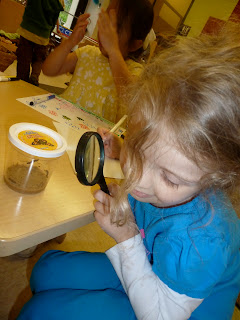Kailyn announced as she was standing on the table, applying tissue paper and glue to our paper mache flower stems , "
art is really, really fun and good for the community".....
The children were excited to begin stage two of our paper mache flowers. We had waited a few days for the paper mache to dry and today we decided was a great time to begin changing the feeling of this sculpture into a flower. But how....
We knew we wanted to continue to develop a textural feeling and wanted the children to have as much hands on experience in the process as possible. Using tissue paper and watered down glue seemed like a perfect medium to introduce and use in this project. We selected various shades of green, aqua and yellow tissue paper and cut the paper into squares. The children used medium sized paintbrushes and applied watered down glue all over the paper mache structure we had built last week. The children especially enjoyed the large motor experience of painting in large strokes and moving, climbing and bending as they 'painted' and tissue papered the stem. The work was collaborative and the children worked together in close quarters respectfully and joyfully.




The children wanted to continue to work with the tissue paper even when the 'stem' was totally finished. We decided to use heavy cardboard tubes and create a few more larger than life flowers. We felt that the learning and work in this area just was not quite finished for the children and they would benefit and enjoy continuing the exploration of this process. We will again paper mache the stem structure later this week and tissue paper the next layer when the structure dries.





















































